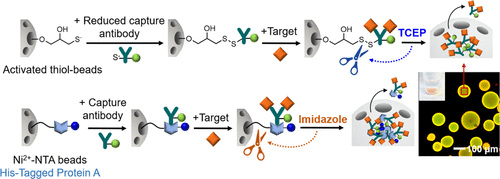Our official English website, www.x-mol.net, welcomes your
feedback! (Note: you will need to create a separate account there.)
Bead-Based Immunocomplex Entrapment Assays for Rapid, Sensitive, and Multiplexed Detection of Disease Biomarkers with Minimal User Intervention.
ACS Sensors ( IF 8.2 ) Pub Date : 2019-12-23 , DOI: 10.1021/acssensors.9b01970 Yuhui Gong 1 , Gerard Marriott 1
ACS Sensors ( IF 8.2 ) Pub Date : 2019-12-23 , DOI: 10.1021/acssensors.9b01970 Yuhui Gong 1 , Gerard Marriott 1
Affiliation

|
Current interest in at-home diagnostic devices derives from their potential to disrupt expensive and time-consuming hospital-based diagnostic practices. Conventional immunoassays are often touted for use in at-home diagnostic devices, although in practice they are slow, labor-intensive and require expensive equipment. Here, we introduce bead-based sensors as alternative biomarker detection platforms for at-home diagnostic devices. The immunocomplex entrapment assay (ICEA), and the related enzyme-linked ICEA (ELICEA) offer enhancements over conventional immunoassays in terms of their speed, and minimal requirements for user intervention and instrumentation. In particular, we designed bead-based sensors to entrap large molecular weight complexes between target molecules and signal-generating immunoconjugates while allowing any unbound conjugates to escape from the bead. Confocal fluorescence microscopy was used to demonstrate the sensitivity, robustness, and reproducibility of the ICEA and ELICEA platforms. For example, we showed the intensity of signals generated by entrapped immunoconjugate complexes correlate linearly with the concentration of target molecule in the sample. We employed ICEA, and ELICEA platforms to detect human forms of immunoglobulins, albumin, and κ light chain (KLC). For example, we used ICEA to detect KLC at 5 μg·mL-1 in urine, which would allow for earlier diagnosis of Bence-Jones disease compared to conventional assays. In addition, we showed bead-entrapped phosphatases (AP) in immunocomplexes generate insoluble, blue-colored dyes from AP-substrates that accumulate in beads and allow for visual and cellphone camera-based detection of IgG to 10 ng·mL-1 within 20 min. Finally, we described ICEA and ELICEA platforms to analyze multiple target proteins within individual beads.
中文翻译:

基于珠子的免疫复合物包埋测定法,可以以最少的用户干预快速,灵敏和多路检测疾病生物标志物。
当前对家用诊断设备的兴趣来自于其破坏昂贵且耗时的基于医院的诊断实践的潜力。常规的免疫测定法经常被吹捧用于家庭诊断设备,尽管在实践中它们缓慢,费力且需要昂贵的设备。在这里,我们介绍基于磁珠的传感器,作为家用诊断设备的替代生物标志物检测平台。免疫复合物夹带测定(ICEA)和相关的酶联ICEA(ELICEA)在速度,对用户干预和仪器的最低要求方面,均优于常规免疫测定。特别是,我们设计了基于珠子的传感器,以在目标分子和产生信号的免疫缀合物之间捕获大分子量复合物,同时允许任何未结合的缀合物从珠子中逸出。共聚焦荧光显微镜用于证明ICEA和ELICEA平台的灵敏度,鲁棒性和可重复性。例如,我们显示了被包埋的免疫缀合物复合物产生的信号强度与样品中目标分子的浓度线性相关。我们采用了ICEA和ELICEA平台来检测人类形式的免疫球蛋白,白蛋白和κ轻链(KLC)。例如,我们使用ICEA在尿液中检测到5μg·mL-1的KLC,与传统方法相比,这可以更早地诊断Bence-Jones病。此外,我们的研究表明免疫复合物中的包裹有珠的磷酸酶(AP)会从AP底物中生成不溶的蓝色染料,这些染料会积聚在珠中,并允许在20分钟内通过视觉和基于手机摄像头的IgG检测到10 ng·mL-1。最后,我们描述了ICEA和ELICEA平台来分析单个微珠内的多个靶蛋白。
更新日期:2020-01-09
中文翻译:

基于珠子的免疫复合物包埋测定法,可以以最少的用户干预快速,灵敏和多路检测疾病生物标志物。
当前对家用诊断设备的兴趣来自于其破坏昂贵且耗时的基于医院的诊断实践的潜力。常规的免疫测定法经常被吹捧用于家庭诊断设备,尽管在实践中它们缓慢,费力且需要昂贵的设备。在这里,我们介绍基于磁珠的传感器,作为家用诊断设备的替代生物标志物检测平台。免疫复合物夹带测定(ICEA)和相关的酶联ICEA(ELICEA)在速度,对用户干预和仪器的最低要求方面,均优于常规免疫测定。特别是,我们设计了基于珠子的传感器,以在目标分子和产生信号的免疫缀合物之间捕获大分子量复合物,同时允许任何未结合的缀合物从珠子中逸出。共聚焦荧光显微镜用于证明ICEA和ELICEA平台的灵敏度,鲁棒性和可重复性。例如,我们显示了被包埋的免疫缀合物复合物产生的信号强度与样品中目标分子的浓度线性相关。我们采用了ICEA和ELICEA平台来检测人类形式的免疫球蛋白,白蛋白和κ轻链(KLC)。例如,我们使用ICEA在尿液中检测到5μg·mL-1的KLC,与传统方法相比,这可以更早地诊断Bence-Jones病。此外,我们的研究表明免疫复合物中的包裹有珠的磷酸酶(AP)会从AP底物中生成不溶的蓝色染料,这些染料会积聚在珠中,并允许在20分钟内通过视觉和基于手机摄像头的IgG检测到10 ng·mL-1。最后,我们描述了ICEA和ELICEA平台来分析单个微珠内的多个靶蛋白。











































 京公网安备 11010802027423号
京公网安备 11010802027423号